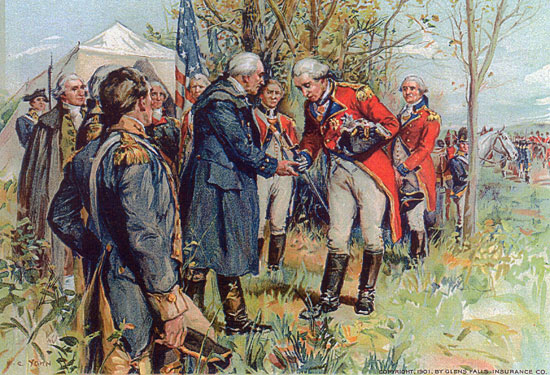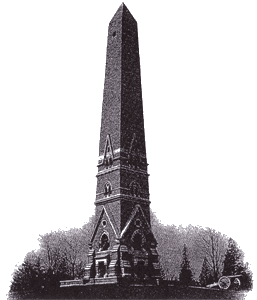| |

At Old Saratoga (now Schuylerville), NY
One of the Fifteen Decisive Battles of the World.
The year 1777 was probably the most perilous period in the "beginning of the
nation," and marked one of the great crises of the world's history. Early in
this year General John Burgoyne succeeded Carleton in Canadian command, and soon entered upon that memorable campaign against the vital
center of the colonies – New York's great confluence of waterways,
Lakes Champlain and George and the' Hudson and Mohawk Rivers.
No part America is richer in historic incident and interest than this
strategic and bloody fighting ground of the ages. The early wars between
savage tribes, the seventy years' struggle between England and France for the
possession of this continent, and the Revolution, made the upper Hudson for a
long period a region of sanguinary events.
The great British campaign of 1777, which promised the dismembering
and crushing of the colonies, included the advance upon Albany by Burgoyne
From the north, Howe from the south and St. Leger from the west. It was
indeed formidable.
On May 10th, with an army of about i0,000 well disciplined and equipped
troops, with many noted generals, and with such confidence that officers' wives
and children accompanied them, Burgoyne ascended Lake Champlain. At
the Bouquet River he was joined by his Indian auxiliaries.
Fort Ticonderoga was captured; Colonel Seth Warner was defeated at
Hubbardton; Fort Ann was taken, and in July Burgoyne triumphantly
reached the Hudson and encamped in the vicinity of Glens Falls and Fort
Edward. Then followed his fatal inactivity and waiting for supplies via
Lake George.
In the meantime the tragic story of the murdered Jane McCrea rang
through the land like a woman's cry of agony, and her name became the
rallying cry for vengeance; Stark had fought and defeated a British
detachment on New York soil near Bennington; Oriskany had
been suffered and St. Leger had retreated from Fort
Stanwix – all to the arousing encouragement of the
colonists, until September 19th, at Bemis Heights,
Burgoyne discovered in the fight of that day
that a dangerously resolute and determined
army was before him. Waiting nearly
three weeks, he again, October 7th.
assumed the defensive and suffered
defeat. His attempted retreat was
prevented, and October 17th he surrendered to General Gates. These
engagements are known as the battle
of Saratoga.
Burgoyne's surrender was made the
subject of the Glens Falls Insurance
Company Calendar for 1902, being one of a series of local historical illustrations which
it has used. This sketch is a reproduced reproduction of a careful
study at this event by the. historical artist, Mr. Yohn, whose larger original is owned
by the Glens Falls Insurance Company.
THE SURRENDER.– At 1t o'clock a.m. of October 17th, 1777, Burgoyne's
army laid down its arms. The only Americans who saw this "grounding of
arms" were two aids of General Gates, and afterward, as the surrendered
army passed between lines of the victorious army, there was no indication of
exultation – a delicacy which was mentioned by Burgoyne and his officers.
A little after the laying down of arms Burgoyne and his staff, in scarlet
and gold, rode to the headquarters of General Gates, who was plainly clad,
his outside garment being a blue overcoat. "The Fortune of war, General
Gates, has made me your prisoner," said Burgoyne, and Gates gracefully
replied: "I shall always be ready to testify that it has not been through any
fault of your excellency."

Saratoga Battle Monument
At Schuylerville NY (old Saratoga), on the site of Burgoyne's fortified camp,
overlooking place of surrender. Cornerstone laid October 17, 1877; completed June,
1883. Height, 154 feet; base, 40 feet square. One hundred and eighty-four steps
lead up to highest windows, which, being 400 feet above the Hudson River, command a
beautiful view north to Glens Falls and from ten to thirty miles in other directions.
|
They dined together at a table of boards laid on empty barrels, and as the
unarmed English army approached on its march to Boston, the two generals
stepped out in front of their tent in view of both armies. General Burgoyne drew his sword, bowed and presented it to General Gates, who
bowed, received it and resumed it to General Burgoyne. General Schuyler,
who had been unjustly superseded in command by General Gates before
the battle, magnanimously called, in citizen's clothes, on Gates to congratulate him, and was present at the surrender. Such was the simple ceremony
that marked the great turning event of the Revolution.
THE MONUMENT which marks the spot can be plainly seen
from the tower of the Glens Falls Insurance Company's building, and is
considered one of the finest of its kind in the world. Over the entrances are seven-foot bronze statues of General Schuyler,
looking east; General Morgan, looking west; General
Gates, looking north. The fourth niche, facing the field
of his most brilliant deeds, is vacant, but would
have honored Arnold had his wound at Saratoga
been fatal or his after treachery never been
perpetrated. inside are a number of
bronze reliefs and busts and room for
many more to be added. It is a grand
educational edifice, commemorating a
grandly conspicuous event in the chronicles of the world.
It is hoped that this brief reference
to this decisive battle may lead many
to study the history of this important
campaign.
Back to the Stories of the French & Indian and Revolutionary Wars. |


